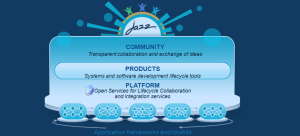My previous post titled “System of Systems Engineering: Part I – Challenges” discussed the challenges organizations face with complex System of Systems (SOS) engineering programs. In this post, I will discuss a potential solution for these challenges by leveraging the IBM Rational Collaborative Lifecycle Management (CLM).
This post is based on a paper I previously written about four years ago when I was part of the IBM Software Group covering the Rational solutions. Therefore, it is biased towards the IBM offerings in the software delivery space. The content of the paper was based on several other IBM intellectual capital (IC). Excerpts from the ICs are included as-is. While the recommended tooling addresses the full scope of the software delivery lifecycle from inception to production, it is not necessary that you should view the solution as an “all or nothing” proposition. The intent is to highlight the problem areas and make you aware of how the IBM Rational solution addresses them.
System of Systems Engineering: Overcoming the Challenges
Considerable research and innovation in software engineering practices during the last decade have resulted in a set of practices that address the risks associated with the System of Systems (SOS) engineering challenges and improve program outcomes. These industry-best practices allow complex programs to execute across temporal, geographical, and organizational boundaries by incorporating modern collaboration tools and federating accessible repositories of lifecycle artifacts such as High Level Architectures and Requirements, Component Architectures, Project Plans and Work Items, Test Plans, and Test Results.
IBM Rational recognized these challenges. IBM also recognized the shortcoming of the point to point integration of many of the development tools including open source and vendor supplied, in addressing the real needs for successful SOS programs. After all, many of these tools were deployed on the very same SOS programs that failed in the past.
[AdSense-C]
It was apparent in order to drive project success more is needed than sophisticated software tools. Instead, a framework is required that addresses the challenges of software delivery. IBM Rational envisioned an approach with the potential to radically change how business and systems software is created and deployed. This vision was realized in the IBM Jazz™ platform (www.jazz.net)— an initiative that revolutionized how people work together to develop and deliver software. The Jazz platform was build from the grounds up and is uniquely attuned to the needs of distributed teams. It combines an awareness of people, projects, and processes, with automation to accelerate the software life cycle and improve project governance.
The IBM Rational proposed solution is based on the Jazz platform. It incorporates three principles as part of an SOS software delivery to significantly improving the outcome for successful projects. First, it provides an efficient collaboration between all members of the development party which is critical to the success of these type of projects. Second, it automates as many tasks as possible to reduce the operational cost and the likelihood of human error. Third, it provides accurate information required to managing the development process and makes the information easily available to a multitude of stakeholders.
The proposed solution provides greater unification of diverse teams, streamline agile development and automate governance to simplify the delivery of SOS programs. Unlike the traditional approach, the solution provides a single integrated environment for software delivery teams and stakeholders to help with agile planning, project governance, version control, task tracking and workflow, and continuous build. In short, it can help manage complex SOS environment so software quality is improved, risk is reduced, team efficiency is increased and delivery efforts are accelerated with a higher rate of project success.
The IBM Rational proposed solution tackles all key challenges SOS programs has faced in the past that contributed to majority of their failure. The successful delivery of an SOS program requires that all stakeholders be able to communicate efficiently and collaborate with ease, no matter where they are located or what role they play. Collaboration drives consensus among the involved parties around program objectives and enables distributed teams to work in unison and create value faster. This kind of collaboration helps drive priorities among teams, improving workforce productivity.
The IBM Rational proposed solution enables people in different roles to see data that is specific to their needs. This is another critical aspect of collaboration that drives project success. For example, a manager who tries to capture the accurate state of a project needs to see the right information, not all available data. Similarly, developers need to be free to focus on writing the best code possible in the most efficient way and not be burdened with providing additional data solely to populate a reporting tool.
In my next post, I will address the benefits of the IBM proposed solution.
About the Author
 Sami Joueidi holds a Masters degree in Electrical Engineering and an Enterprise Architecture certification from Carnegie Mellon. He has over 20 years of experience as a technical leader of complex IT projects for Fortune 500 firms, in diverse roles such as Systems Integrator, DevOps, Cloud Architecture, Enterprise Architecture and Software Development & Release Management. He guides customers on how to leverage the latest technology trends to their advantage and helps them with their Cloud adoption strategies.
Sami Joueidi holds a Masters degree in Electrical Engineering and an Enterprise Architecture certification from Carnegie Mellon. He has over 20 years of experience as a technical leader of complex IT projects for Fortune 500 firms, in diverse roles such as Systems Integrator, DevOps, Cloud Architecture, Enterprise Architecture and Software Development & Release Management. He guides customers on how to leverage the latest technology trends to their advantage and helps them with their Cloud adoption strategies.
© Sami Joueidi and www.cafesami.com, 2015. Excerpts and links may be used, provided that full and clear credit is given to Sami Joueidi and www.cafesami.com with appropriate and specific direction to the original content.


Do you like to comment?